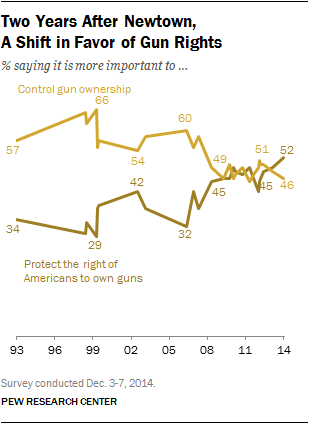Forget D.C., States Take Very Different Paths on Guns
Tighter gun laws or looser firearms restrictions? They're both coming to a state near you.

Is America once again splitting into free and unfree states? At least on the issue of self-defense rights, that seems to be the case—so says Jennifer Carlson, a University of Toronto sociologist who includes gun issues among her areas of study. At the Wall Street Journal she writes that it no longer makes sense in the United States to talk about national gun policy, but instead to recognize widely divergent trends at the state level that are taking Americans in different political, cultural, and technological directions.
In her writings, Carlson has long talked about gun cultures in the plural. Americans in general, she says, generally adopt guns as part of the adoption of a "citizen-protector" role that involves taking on a position of full responsibility in society. But African-Americans also tend to take to firearms as a counter to hostile police and distrusted authorities. Women are sufficiently involved in gun ownership and use that the breast cancer awareness campaign catches their eyes with specially packaged shotgun ammo.
So there's not a monolithic gun culture, there are different people using firearms for different reasons, though with plenty of overlap. But that divergence also involves gun policy, and with the sides dug in different states are headed in very different directions. According to Carlson:
Gun-control initiatives will follow the approach blazed by the gun lobby, shifting away from the national stage and focusing increasingly on state-level efforts in places like California, Colorado, Connecticut and Washington. With the gun debate focused on state-level politics, high-profile shootings will exacerbate the division between these two Americas: in restrictive states, a demand for more laws; in permissive states, a demand for more guns.
That tight national restrictions are off the table seems highly likely. Support for gun rights has trended upward for years, even with gun-controllers pushing to exploit every horrific crime. According to Pew Research Center, "For the first time, more Americans say that protecting gun rights is more important than controlling gun ownership, 52% to 46%."
Some states have passed intrusive gun laws, including California, Colorado, Connecticut, and New York. But more states loosened laws after Newtown than tightened them. Texas is on the verge of allowing open carry, the sort of visible firearms presence that Carlson suggests reduces the taboo around firearms and gun ownership and makes them part of the accepted culture.
My own experience mirrors that. Even as a gun rights supporter, and illegal toter of guns in eastern cities, I was surprised when I moved to Arizona and saw guns in plain view on people's hips. Now they're just fodder for show-and-tell at dinner parties.
Gun controllers counter that gun ownership is declining, according to surveys. But that flies in the face of soaring gun sales figures and industry numbers showing that the percentage of first-time owners among gun buyers has been rising and now stands at a bit over 25 percent. Unless the old owners are dumping their guns in landfills, people are probably telling anonymous surveyors one thing while doing another.
But, according to Carlson, that ownership will be increasingly polarized politically and geographically. And Pew numbers reflect just that, with growing support for gun rights among conservatives and moderates, and rising support for restrictions among liberals. Geographically, the South and Midwest show growing support for gun rights, wiith rising support for restrictions in the Northeast and West (I'm looking at you, California).
So that overall national preference for gun rights over gun control reflects real regional and partisan differences. Those are most easily broken down, policy-wise, at the state level.
Which, strictly speaking, is how a federal system is supposed to work. That's not to say that individual rights of any sort should be subject to majority vote. But to the extent there's a critical mass anywhere for more state intrusion that can't just be blocked, authoritarian laws should be inflicted only where they're most strongly favored and not exported elsewhere.
Interestingly, Carlson extends her divergent projection to technology, but recognizes that innovations may not just split along regional patterns.
Gun entrepreneurs will market "smart guns," which use identification technology like fingerprint recognition to make a firearm inoperable in the hands of unauthorized users. However, these efforts may be counteracted by the proliferation of "disposable" guns, which are inexpensive, untraceable weapons created with 3-D printer technology and which often can be used only a limited number of times because of the materials used.
Smart guns will gain some traction in restrictive states, but 3-D printing technology will appeal to do-it-yourself gun aficionados who love to tinker and to the underground market, which seeks untraceable arms.
Different states are choosing very different policies when it comes to private gun ownership (they never disarm their own enforcers, of course), and they may well continue to do so. But those states that adopt more restrictive policies will discover, as always, that actually disarming their citizens is a lot more challenging than revising the law books.


Show Comments (96)